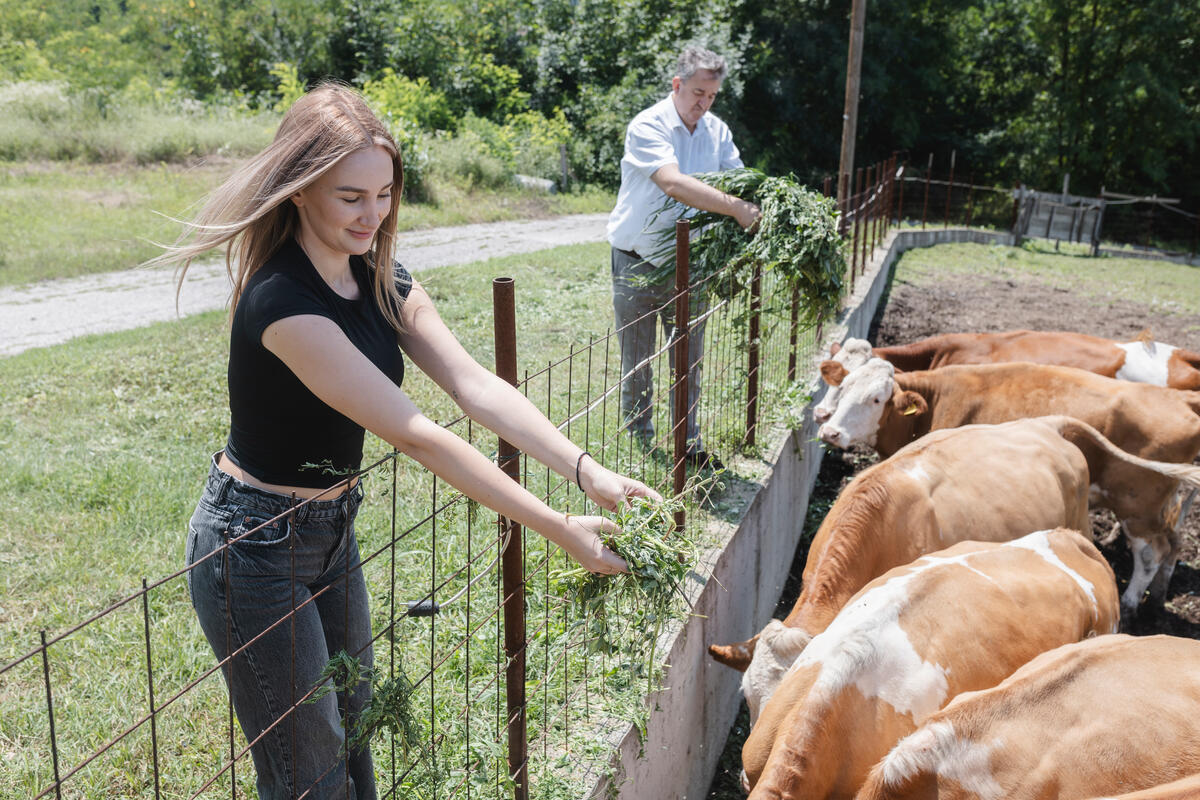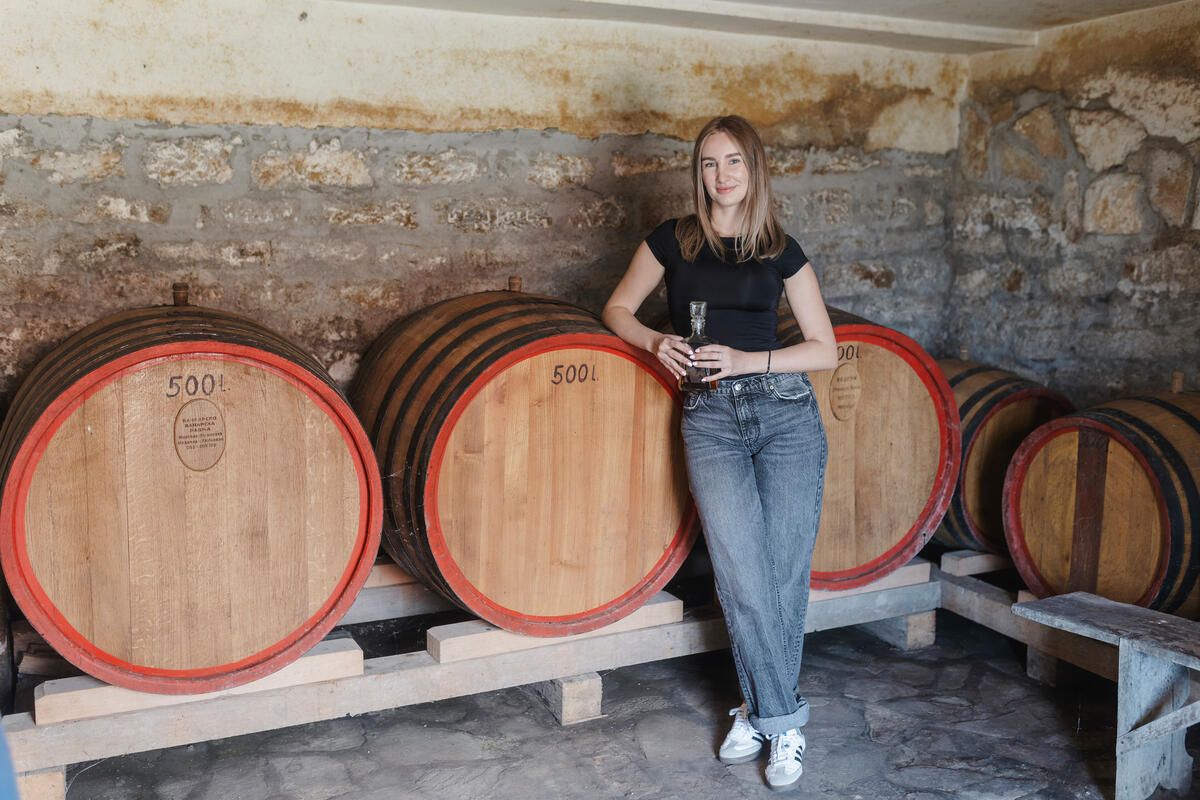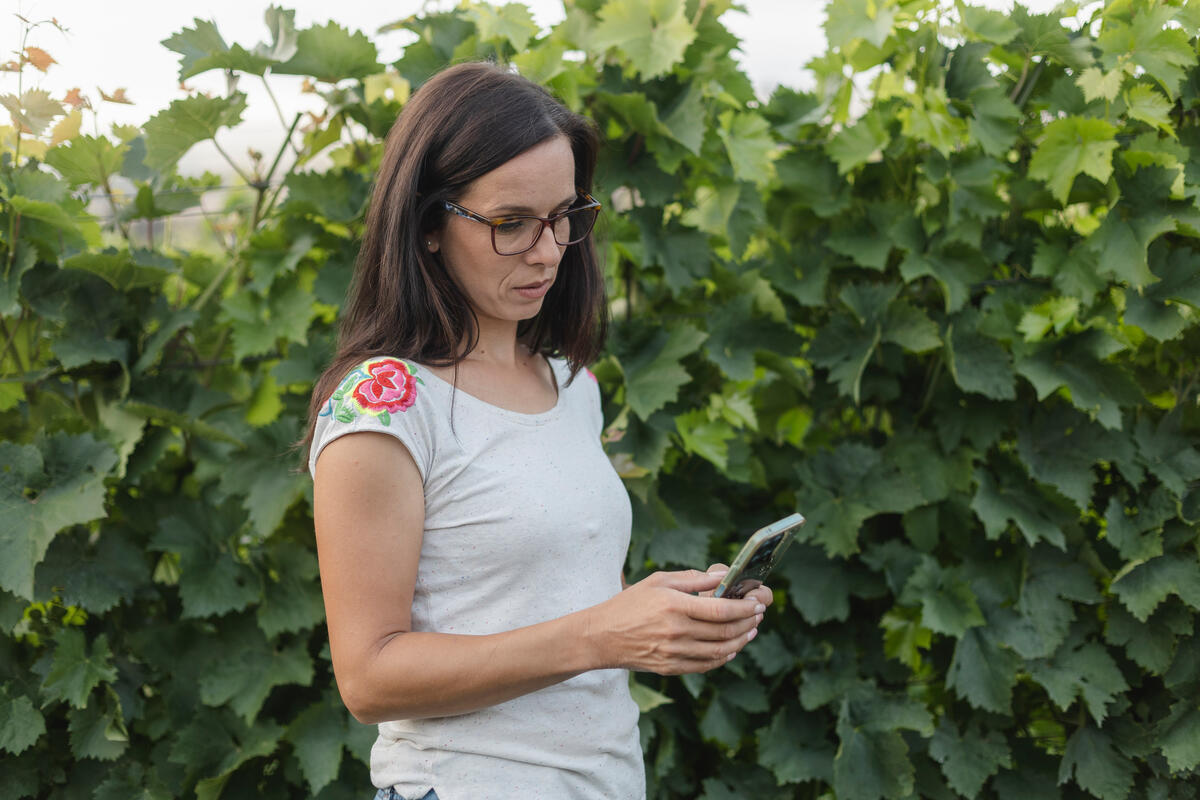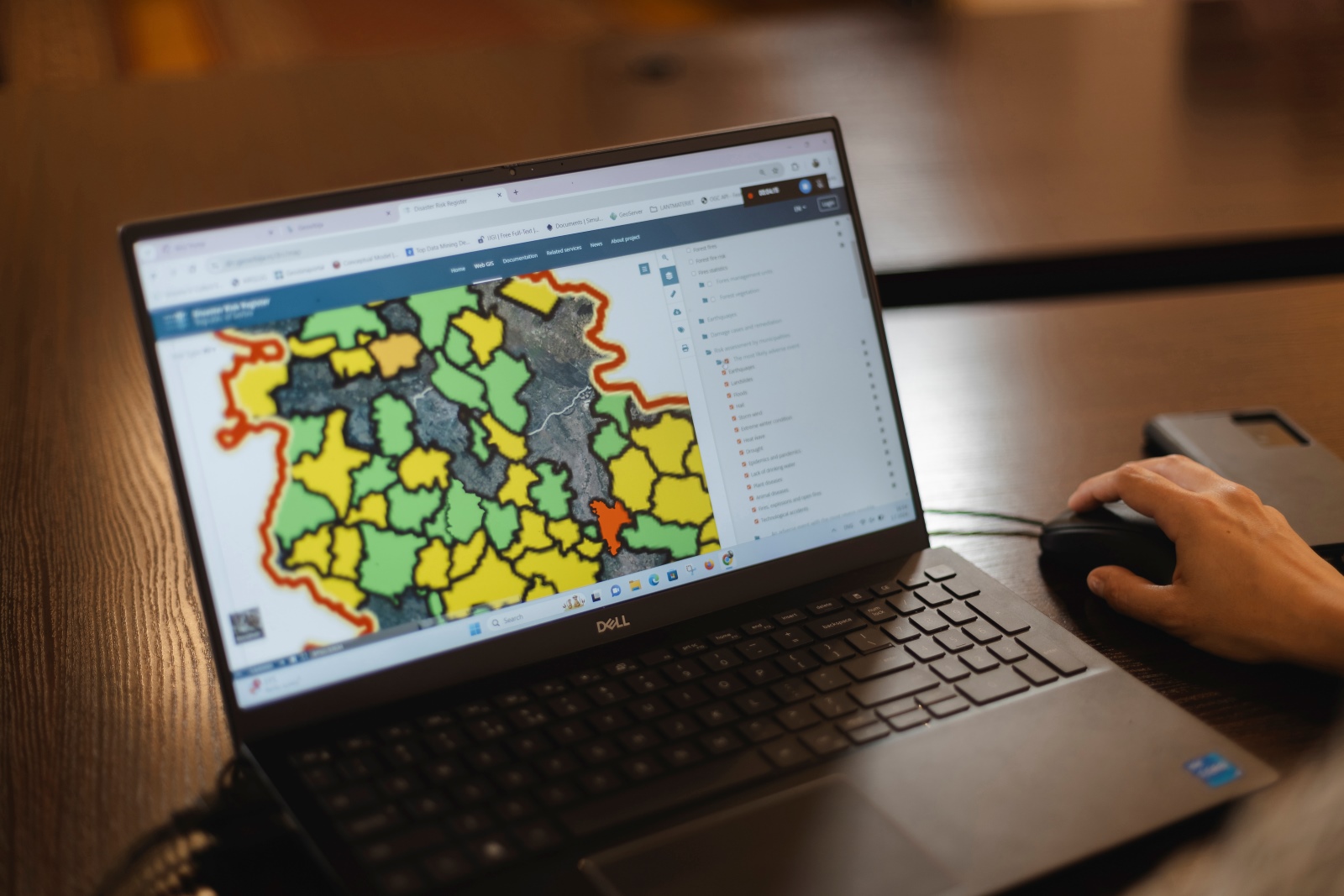Securing land rights with just a few clicks
How digitalization in Serbia protects land rights for future generations
28/04/2025
Intently typing on his mobile phone, Milivoje Ćosić, a smallholder farmer, university professor and a father of three, throws glances from time to time at a sun-lit lawn where his cows are grazing at the distance. He is standing in front of his house in the Serbian village of Mionica, some 100 kilometres southwest from the country’s capital, Belgrade.
His mother Isidora and daughter Irina are bustling about in the kitchen. Minutes later, Irina appears in a doorway bringing out traditional hot burek pie. The table is already filled with a wide variety of homemade breakfast foods: fresh eggs, cheeses, cured meat and hot bread from the oven. The smell of coffee prepared in a traditional cezve pot completes the morning picture.


“I inherited this farm together with my brother and sister, from our father, our uncle and our grandfather,” Milivoje says smiling with obvious pride. “Today, our land is properly registered and can be found in the cadastre online.” He shows the screen of his mobile phone, pointing to a digital platform which provides data on the online cadastre records, proving instantly that his name is officially attached to the land.
This has been made possible thanks to a large-scale digital transformation of Serbia’s real estate registration systems, facilitating digitalization across many sectors of the economy, including the agrifood sector.
Just a few years ago, registering of land or changes in property rights, such as an inheritance or a purchase, was a time-consuming and often costly process in Serbia. It would take months to register a transaction. Data were fragmented, unreliable and not easily accessible, often available only in analogue archives. The process of obtaining the documents to prove someone’s land rights usually required several visits to the cadastre offices, which could be in another village.
All of this changed in 2015, when Serbia’s Republic Geodetic Authority (RGA) — a specialized state institution that collects, connects and distributes national geospatial and real estate data— launched the Real Estate Management Project, funded by the World Bank and technically supported by the Investment Centre of the Food and Agriculture Organisation of the United Nations (FAO). The aim was to scale up investments by increasing the transparency, accessibility and reliability of property management systems and to clarify land tenure issues for citizens, farmers, businesses, government agencies and municipal institutions.
Land tenure is a cross-cutting issue that underlies all sectors of the economy. Accordingly, FAO provides support to governments and institutions in this area and was therefore well-placed to support RGA with technical know-how and experience in country-tailored solutions related to the digital transformation of land administration.
The FAO-supported, World Bank-funded project integrated data from several different information technology systems including the address register, the digital archive, the national spatial data infrastructure and others into one, known as the Integrated System for the Real Estate Cadastre. This simplified business processes and significantly minimized the time needed to register land transactions.

Agriculture online
Digitizing its business processes and the huge quantity of analogue archives, Serbia’s Integrated System for the Real Estate Cadastre now provides an easy access to all records and enables the data to be shared seamlessly with other institutions’ e-services.
Furthermore, the project supported the development of GeoSerbia, a national platform for sharing and distributing spatial data. By providing access to 335 geo-spatial datasets, businesses and government entities can harness this information to develop their own related applications and platforms. For example, the Ministry of Agriculture developed a system, called eAgrar, allowing users to register farms and apply for agricultural subsidies. With this tool, farmers no longer need to go to the Cadastre to obtain documents for their land rights and pay for those services; they can instead access the records for free from the eAgrar, which is linked to the eCadastre.
For his part, Milivoje is using the eAgrar system to apply for agricultural subsidies online, directly from his home. He says that, in the agriculture sector, digitalization brought a lot of benefits, including easy farm registration and simpler procedures to apply for subsidies, making the farming business suddenly more appealing for younger generations.
In Serbia, like in most countries, the agriculture sector is facing a crisis of ageing. Often the younger generations are less interested in following in their parent’s agricultural footsteps, with the outdated perceptions that agriculture is only hard work with little pay.
Digitalization is helping to turn around these viewpoints and offer young people the opportunity to explore careers in agri-businesses.
“Agriculture in Serbia has now become easily accessible to us young people in particular because we are ‘a one click generation’,” Irina chuckles.


Although Milivoje’s children all decided to study abroad, they each wish to return to their native country and benefit from their secured land rights, taking the opportunity to start their own agri-businesses. Irina, for example, is hoping to produce rakia (a local type of brandy) and continue her family’s production of local cheese and prosciutto.
“I graduated from university in Barcelona, and I decided to return to Serbia because I am keen to develop my own brand of rakia from the local plum orchards. It will be ecological. My dream is to market it all over Europe and ultimately the world, to make a Serbian brand recognizable,” she says, her eyes filled with excitement.
“I decided to do it in Serbia because I want to continue the business of my ancestors and make my family proud.”
After breakfast, Irina follows her farther to the farm facilities to feed cows and chicken. She loves watching the animals and feels serene and content interacting with nature, away from the hectic city life.
Irina also hopes to develop agritourism and eco-tourism in this region. “It is a very attractive area,” she continues with undisguised enthusiasm, “It has a lot of hot springs that can be turned into natural spas and attract tourists.” She is considering building a little guest house for tourists, to whom she can serve their fresh farm produce: vegetables, fruit, eggs, home-made cheeses and meats.
Strengthening women’s land rights
Just down the road, another family farmer, Marija Stojiljković, sits on a bench outside her house after a hard day working in her orchard. Cup of coffee in hand, she looks at the neat rows of vineyards, their leaves displaying drops of rainwater that glitter under the setting sun.
When asked about her farming business, her eyes light up. She enthusiastically recounts her daily routine – talking about activities which constantly bring her joy and fulfilment.
“This farm is a family farm. I run it together with my husband… Every day of the year I work in the garden. Depending on the season, me and my husband prune and water the trees, apply nutrients as well as various treatments to protect the plants from pests, diseases and weeds, and of course, harvest the fruits.”
“Taking care of a fruit tree is like taking care of a child,” she adds with a smile. This simile is all the more pertinent when talking about custodianship and legal rights.
Though the Civil Code in Serbia has always provided equal property rights for both spouses in a married couple, in practice often only a husband’s name appeared in the register. This meant that in the case of a sale, for example, proving women’s land rights required additional documents. However, now, in a move to protect women’s land rights, it is mandatory to include both spouses in the property registration - a legal change which was also reflected in the new cadastre system. This has meant that, the share of property records with women as owners or co-owners has significantly increased.
The new automated property registration system is further helping identify the areas where women’s land rights are low by generating gender disaggregated reports, thus providing critical information for the institutions to focus their efforts on the areas with significant inequality. These changes are helping Serbia meet the Sustainable Development Goal (SDG) target on gender equality in land ownership and control.
Marija inherited her land from her family and is happy that her land rights as a woman are now protected and her children can benefit from the secure land rights in the future.
“Because everything is registered now, my property rights are secured and can be easily tracked down in the system,” says Marija.
When land rights are not registered in cadastral system, there can be misuse or double claims. Now eAgrar checks the land plots and the associated usage rights in the cadastre database directly.
Simplification through digitalization
While initially, Marija and other farmers, especially elderly ones, had doubts about using digital instruments and applying for subsidies through eAgrar, these were dispelled quickly.
“Honestly, at first, I was skeptical about digitalization. I thought it was too complicated for me and that I wouldn't be able to manage it. When I found out that eAgrar is connected to the eCadastre, I was pleasantly surprised because it's all become so easy, fast and simple …. All you need is a mobile phone and internet, and everything is done from the comfort of your home,” explains Marija.
Before the digitalization, farmers used to spend between seven and nine days applying for the subsidies. Now through eAgrar application, it only takes a few minutes, and it is a transparent process.
“We literally had to set aside a whole day to comply with the legal requirements to apply for subsidies. It involved gathering a huge amount of paperwork prior to that and just when your turn comes, they say you are missing one piece of paper, and then you have to start all over again and that was really difficult for us and took up a lot of valuable time,” describes Marija.
This echoes the sentiments of Milivoje and other Serbian smallholder farmers who constitute around 95 percent of all Serbia’s agricultural holdings.
“Digitization is an exceptional step forward in the direction of faster resolution of property legal problems, especially for us, older people,” says Radisa Stankovic, a former mayor of the city of Mionica, and now a retiree. “Now we have a call centre at our disposal which can help us to understand how to submit requests through the new system, since the majority of elderly people do not know how to use computers.”


Broad benefits
While the e-cadastre was hugely beneficial to farmers in terms of offering a fast and easy way to validate their land rights, the platform benefitted a much broader range of society, including government officials, municipalities, legal professionals, surveyors, bankers, real estate agents and business owners.
Citizens do not need to visit the property registration offices anymore. Notaries and lawyers have access to all real estate records, including the digital archive, and can prepare and submit documentation for property registration to RGA on behalf of their clients.
Now the registration of purchase contracts or formalizing inheritance rights can be completed within just four days. When individuals used to have to register property in person, the registration would take an average of 45 days and, in some cases, years. Now people can track the status of their applications online.
“The cadatsre system is not just a bunch of machines, terabytes or pieces of metal,” said Žarko Mihailović, director of a public notary office in Belgrade. “It is about making people happy and making them feel more safe and secure about their future and the future of their children.”
Moreover, individuals can now get electronic “alarm” notifications by SMS to be alerted about any changes in their property records. Mirjana Sakić, a pharmacist, shares how this digital alarm service helped prevent fraud. “By registering for a cadastral alarm, I found out that another owner had registered my apartment. Thanks to this digital service, I literally saved my own apartment, and I was so close to losing my property.”

Detecting potential risks
Using data from GeoSerbia the government, in coordination with RGA, developed an innovative platform, called the Risk Register, which helps local authorities identify risk zones, such as flood-prone areas or earthquake fault lines. This application then provides information to decision-makers, when and where needed, to undertake preventive measures, respond quickly to natural disasters or aid in post-disaster recovery.
For example, all flood zones in Serbia are registered using historical data. By overlapping data sets with current imagery on buildings, utility lines, etc., the government can detect which objects are in danger, allowing it not only to react in a timely fashion, but also to plan for the needed funds in emergency situations. The project has also provided mass property valuation data, which is crucial for fast estimation of compensation to farmers and other citizens in case of damage to their land and property by natural disasters.

With support from the World Bank and FAO’s Investment Centre, Serbia has been able to modernize and digitally transform its land administration system which has been key to the country’s sustainable development. By providing up-to-date information when and where needed for more informed policies and regulations related to land, property rights and natural resources, this digital transformation serves as a model for other countries to customize and replicate, creating opportunities for younger generations and inspiring further innovations.
“I hope that digitalization will attract and motivate younger generations specifically my children to continue our family business. And that they will improve and modernize our production and make an even better story than what we started,” Marija says.
This is part of a series of stories to mark the 60th anniversary of the FAO Investment Centre, highlighting decades of partnerships, initiatives and investments that have shaped agrifood systems. Explore how the FAO Investment Centre continues to drive agricultural investment and finance solutions, transforming lives globally.

